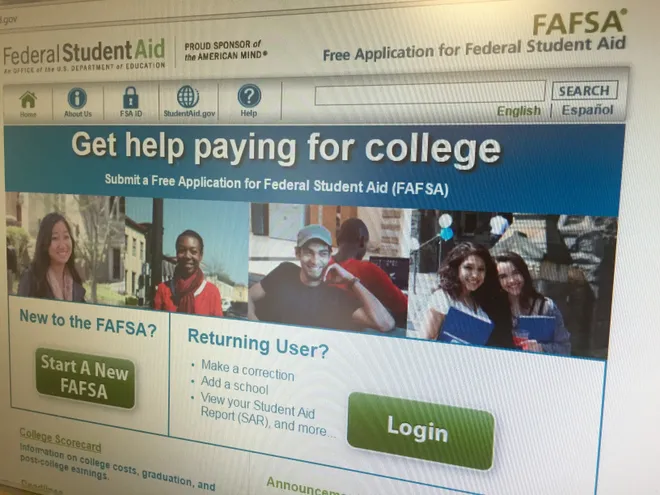FAFSA's the main source of student aid but don't miss the CSS profile for a chance for more
A new school year just started, but it’s never a bad idea to plan for the next one, especially when you need help paying for your education.
The best tool to get student financial aid is the 2024-25 Free Application for Federal Student Aid (FAFSA) form, which will launch later than usual this year. The form is expected to be available in December, instead of October, with a new simplified look and a new calculation to determine your eligibility. However, that’s not the only way Americans can pay for school.
Families also can apply for financial aid at certain schools using the College Scholarship Service Profile (CSS profile). They’ll still have to complete FAFSA, but the CSS profile can provide an opportunity to get other financial help.
The process can be confusing so here is a breakdown of the differences between the FAFSA and CSS profile. You can decide if completing the CSS profile is worth your time.

What is FAFSA used for?
Completing the Department of Education’s FAFSA is the only way you can be considered for federal student aid. The free application for the 2023-24 school year is available now to complete online, on mobile app or by mail and is due no later than 11:59 p.m. CT on June 30, 2024. The 2024-25 FAFSA opens in December and is available through June 30, 2025.
Learn more: Best personal loans
States and colleges also use FAFSA information to award their own grants, scholarships, and loans. States and colleges have their own deadlines, so you need to check and meet those due dates.
International students aren’t eligible for federal aid but should complete FAFSA anyway because some schools may require it to determine from where they can receive aid. However, without a Social Security number, they won’t be able to complete the form online. They’ll have to print, complete and mail it.
What is the CSS profile used for?
The CSS profile is an online application that students submit to apply for financial aid from colleges and scholarship programs. It’s run by the College Board, which also administers standardized college exams like the SAT.
While any school that grants federal financial aid accepts FAFSA, only about 400 colleges, universities, and scholarship programs use the CSS profile to award more than $9 billion in grants, the College Board said. You need to check which ones do. The application opens October 1 for the following school year and deadlines vary from school to school.

The CSS profile is free for domestic undergraduates with family income of up to $100,000. Otherwise, the cost to submit is $25 for the first application and $16 for each subsequent application. You might also qualify for a fee waiver if you received an SAT fee waiver or you’re under 24 years old and a ward of the court or an orphan.
International students can use the CSS profile to find financial aid.
Do FASFA and the CSS profile calculate aid in the same way?
No.
- Under FAFSA, the amount families can contribute is subtracted from the cost of attending school. What families can afford is determined by income, assets and benefits such as Social Security or unemployment. Starting in 2024-25, some farm assets will be counted, too, but siblings in college won’t be factored into the calculation. Both could lower the amount of aid families may receive. You can use the Federal Student Aid Estimator when it's available to see what you be eligible for.
- The CSS profile requires more financial information, including both parents’ income, home equity, medical expenses, non-qualified annuities, the value of small family businesses and special circumstances that might affect your family’s ability to pay. Unlike FAFSA, there’s no set formula to calculate aid. College financial aid offices have the flexibility to add more questions and interpret families’ information to determine the amount students receive.
Find a scholarship:The 10 best sites to search for scholarships
Should I complete both FAFSA and the CCS profile?
Students should definitely complete FAFSA, even if they think they may not qualify for any aid.
"Contrary to popular belief, you may qualify for federal student aid because it doesn’t have an income cut-off,” the Department of Education says. “Also, the FAFSA form is not only the application for the Federal Pell Grant. It’s also the application for Federal Work-Study funds, federal student loans, and even scholarships and grants offered by your state, school, or a private organization.”
If your school accepts the CCS profile, advisers say you should apply because the CCS profile considers a family’s financial situation -- not just income, assets and family size.
“You never know what kind of additional funding might be available to you beyond what the FAFSA can provide,” according to the nonprofit Grantford, which helps students get the best financial aid available. “This is especially helpful for lower-income students since it can create a more nuanced picture of the actual amount that the family can contribute to the student’s schooling--which may lead to additional financial assistance.”
Note: Whether you decide to complete the FAFSA, CCS profile, or both, it’s best to do them as soon as possible. Since aid is often first-come, first-served, you can increase your chances of getting more by applying early.
Medora Lee is a money, markets, and personal finance reporter at USA TODAY. You can reach her at mjlee@usatoday.com and subscribe to our free Daily Money newsletter for personal finance tips and business news every Monday through Friday morning.
Disclaimer: The copyright of this article belongs to the original author. Reposting this article is solely for the purpose of information dissemination and does not constitute any investment advice. If there is any infringement, please contact us immediately. We will make corrections or deletions as necessary. Thank you.







